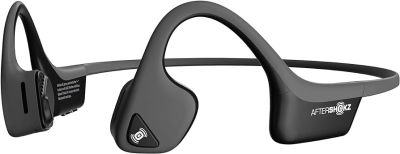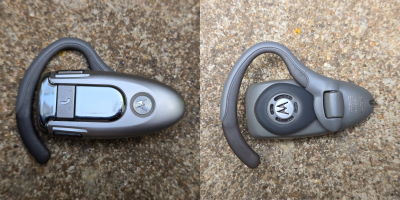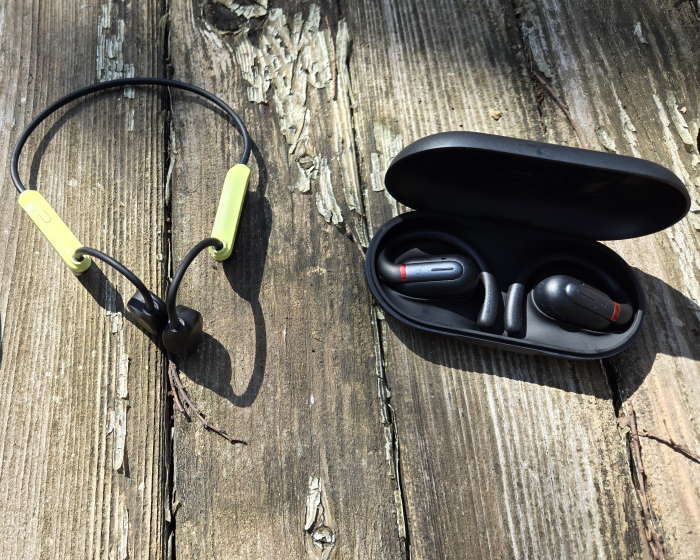Bone conduction headphones have become a popular option during the past decade for some cyclists and other athletes to listen to music or podcasts while on the move. The primary advantage is that users can maintain situational awareness because the ear canal is not covered and outside sounds are not blocked. The primary disadvantage is that the sound quality is substantially inferior to traditional headphones or earbuds. It has been an acceptable tradeoff for me in the past, but recent experience has changed my mind. Below I will tell you why I now think that there is a better option than bone conduction technology for many uses.
My Experiences with Bone Conduction Headphones
I got an Aftershokz (now known as Shokz) Trekz Air open ear bone conduction headset in March of 2019 and used them for a full 5 years. By that point the battery had noticeably decreased in capacity and I retired them when one of the transducer covers fell off. I was satisfied with the durability and longevity of the Trekz Air having survived my daily training and accompanying me on quite a few adventures. As this model had been discontinued long ago, I decided to look around and see what products have emerged since then.

Many years ago, Shokz had the bone conduction market almost all to themselves. In the meantime, many companies have released similar headsets and at more affordable prices. I read a review for a bone conduction headset on Cycling Weekly and purchased a pair. I used the Haylou Purfree Lite headphones for almost 4 months at which point they simply stopped working for no obvious reason. Haylou’s customer support was attrocious and took weeks of back and forth to get them to agree to a warranty replacement. During that time I went looking for something else.
Non Bone Conduction Open Ear Headphones
In the past couple years, many manufacturers have introduced non bone conduction headphones as a competitor to bone conduction technology. The open ear style earbuds are not so much a new technology, but a refinement of old technology with some new twists. The early 2000s gave us the proliferation of wireless Bluetooth headsets that were once a common accessory for cell phones. Unfortunately these devices were often heavy, large, had poor battery life, low quality mono audio not designed for music playback, and poor ergonomics. A couple of decades later now, advances in batteries and electronics are powering a new design of open ear headphones.

Currently there are several distinctly different designs that primarily differ in how they attach to the ear. The most common uses a hook that goes up around behind the ear which is similar to those old Bluetooth headsets. A second style of “c-clip” hooks around the lower part of the ear (see the Bose Ultra Open for one example). Finally, there are unique solutions like the Sony LinkBuds which sit within the ear like a traditional earbud, but have a special ring shaped driver that has a center hole to prevent obstructing the ear canal. All three styles leave the ear canal at least partially unblocked while having a small speaker directed towards it. These are the antithesis of noise cancelling headphones.
I purchased a pair of Soundcore V30i open ear headphones to see if this style of headphones would work for me. The audio quality on even this low end model is superior to any bone conduction headphone. Outside audio and situational awareness was similar to the bone conduction headphones. From a comfort perspective, I found both types to be similar with usage up to about a continuous 4 hours. The V30i have a better fit when paired with sunglasses and a cycling helmet than the band style bone conducting headphones. This is especially apparent when cycling off-road where movement increases the likelihood of the band on bone conduction headphones making contact with your helmet or glasses and causing noticeable disturbances in the audio.
Are Bone Conduction Headphones Better at Anything Now?
There are a few areas where bone conducting headphones can be superior. First, the band style bone conducting headphones are more securely attached to my head. While the individual V30i earpieces generally remained stably attached on local mountain bike trails, contact with a small overgrown branch while riding cleanly removed one from my right ear. I was able to locate it on the ground after doubling back, but it’s something to keep in mind with this style if you ride off-road. Some non bone conducting open ear headphones feature a removable band for added security to help alleviate this potential problem.
the idea of putting walkie-talkies into the helmet.
But we made ours with a special rabbit ear on the
top so we could pipe in some music.”-Steve Zissou
Second, bone conducting headphones can be designed to be more water resistant and some can even operate underwater. The old Trekz Air headset that I had for 5 years had a water resistance rating of IPX5 and survived plenty of rain and sweat. Shockz even makes headsets like the Openswim Pro that are rated IPX8 and designed to be used while swimming. Most people don’t go swimming to listen to music so this is a very niche area. That said, the V30i has a claimed IPX5 rating which should be sufficient for rain, but in practice I did not find this to be accurate. One of the earpieces failed while cycling in the rain within the first month. Was I unlucky and received a defectively sealed unit? My suspicion is that this headset is simply not up to the IPX5 standard so I returned the V30i for a refund.
“There’s an old saying in Tennessee — I know it’s in Texas, probably in Tennessee — that says, fool me once, shame on — shame on you. Fool me — you can’t get fooled again.” -GW
Other Options You Might Consider
There are other options although I do not consider them for myself. One example is the Transparency and Ambient modes of some Apple Airpods and Samsung Galaxy Buds respectively. These technologies use the built in microphones to capture ambient sound and mix it in with the audio of the earbuds. While this can enhance situational awareness, it does not address the other issues of discomfort or potential ear infections associated with traditional earbuds. And there’s always the single mono wired earbud for the traditionalists…
Parting Thoughts
Have I found the perfect way to listen to music while cycling? No, and I don’t think one currently exists as all have some compromises. I do think that the new non bone conduction open ear styles provide better audio quality and look forward to testing some additional models soon to find a pair that can live up to their water resistance rating. I hope you found this article useful in surveying the pros and cons of the current alternatives. My apologies to those who thought I was just going to tell you that you had to rush out and buy a specific product with an affiliate link.
Notice: Outdoor activities such as those described on this site are inherently dangerous. Effort has been put forth to present factual information but no guarantee is made that it is complete or represents current conditions. You assume all risk with any use of the information on this site.





